 | ||
In quantum computing, and more specifically in superconducting quantum computing, the phase qubit is a superconducting device based on the superconductor-insulator-superconductor (SIS) Josephson junction, designed to operate as a quantum bit, or qubit. The phase qubit is closely related, yet distinct from, the flux qubit and the charge qubit, which are also quantum bits implemented by superconducting devices.
Contents
Introduction
A phase qubit is a current-biased Josephson junction, operated in the zero voltage state with a non-zero current bias.
A Josephson junction is a tunnel junction, made of two pieces of superconducting metal separated by a very thin insulating barrier, about 1 nm in thickness. The barrier is thin enough that electrons, or in the superconducting state, Cooper-paired electrons, can tunnel through the barrier at an appreciable rate. Each of the superconductors that make up the Josephson junction is described by a macroscopic wavefunction, as described by the Ginzburg-Landau theory for superconductors. The difference in the complex phases of the two superconducting wavefunctions is the most important dynamic variable for the Josephson junction, and is called the phase difference
Main equations describing the SIS junction
The Josephson equation relates the superconducting current (usually called the supercurrent)
Here
The Gor'kov phase evolution equation gives the rate of change of the phase (the "velocity" of the phase) as a linear function of the voltage
This equation is a generalization of the Schrödinger equation for the phase of the BCS wavefunction. The generalization was carried out by Gor'kov in 1958.
The McCumber-Stewart model
The alternative and direct current Josephson relations control the behavior of the Josephson junction itself. The geometry of the Josephson junction—two plates of superconducting metal separated by a thin tunnel barrier—is that of a parallel plate capacitor, so in addition to the Josephson element the device includes a parallel capacitance
The terms on the left side are identical to those of a particle with coordinate (location)
This is the "washboard potential", so-called because it has an overall linear dependence
The zero voltage state describes one of the two distinct dynamic behaviors displayed by the phase particle, and corresponds to when the particle is trapped in one of the local minima in the washboard potential. These minima exist for bias currents
The voltage state is the other dynamic behavior displayed by a Josephson junction, and corresponds to the phase particle free-running down the slope of the potential, with a non-zero average velocity and therefore non-zero voltage. This behavior always occurs for currents
Nonlinear inductor
Another way to understand the behavior of a Josephson junction in the zero-voltage state is to consider the SIS tunnel junction as a nonlinear inductor. When the phase is trapped in one of the minima, the phase value is limited to a small range about the phase value at the potential minimum, which we will call
If we consider small variations
These variations in the phase give rise to a voltage through the ac Josephson relation,
This last relation is the defining equation for an inductor with inductance
This inductance depends on the value of phase
As the bias current increases, the inductance increases. When the bias current is very close (but less than) the critical current
The nonlinear inductor represents the response of the Josephson junction to changes in bias current. When the parallel capacitance from the device geometry is included, in parallel with the inductor, this forms a nonlinear
which is known as the plasma frequency of the junction. This corresponds to the oscillation frequency of the phase particle in the bottom of one of the minima of the washboard potential.
For bias currents very near the critical current, the phase value in the washboard minimum is
and the plasma frequency is then
clearly showing that the plasma frequency approaches zero as the bias current approaches the critical current.
The simple tunability of the current-biased Josephson junction in its zero voltage state is one of the key advantages the phase qubit has over some other qubit implementations, although it also limits the performance of this device, as fluctuations in current generate fluctuations in the plasma frequency, which causes dephasing of the quantum states.
Quantized energy levels
The phase qubit is operated in the zero-voltage state, with
The phase qubit uses the lowest two energy levels in the local minimum; the ground state
